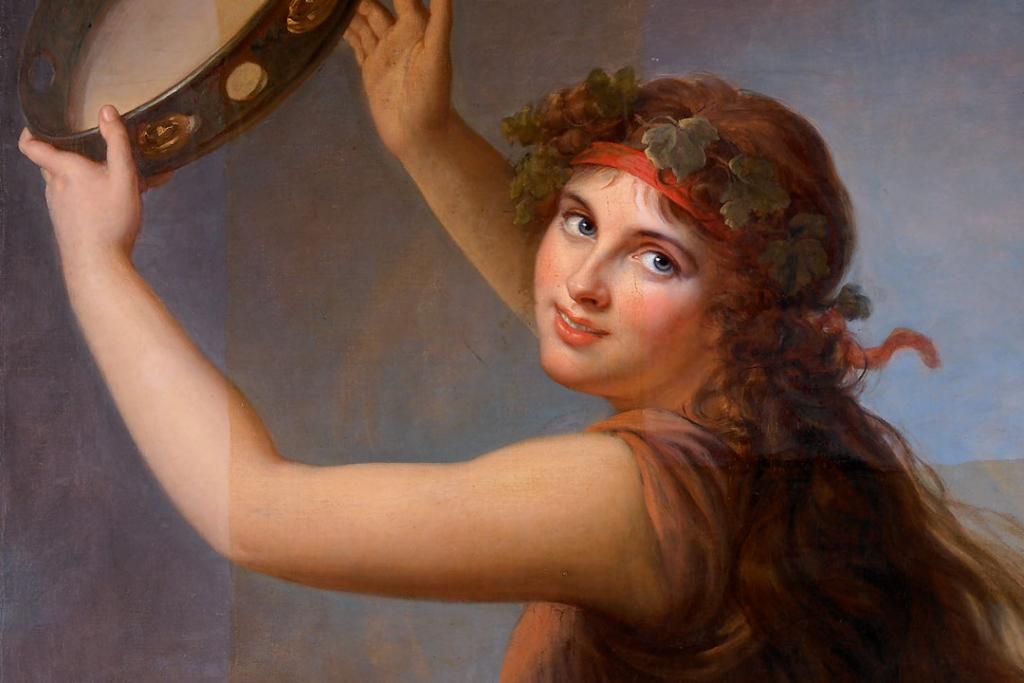Lady Hamilton restored and rediscovered
In summer 2015 Élisabeth Louise Vigée Le Brun’s painting Lady Hamilton as a Bacchante from the Lady Lever Art Gallery was conserved by Kristina Mandy. Kristina joined National Museums Liverpool as a paintings conservator on a six month contract from May to November 2015. She describes her work on the painting, which you can now see back on display at the Lady Lever Art Gallery.

Detail of 'Lady Hamilton as a Bacchante' by Élisabeth Louise Vigée Le Brun during conservation
During my contract at National Museums Liverpool I had the fantastic opportunity to conserve this beautiful portrait of Lady Hamilton from the early 1790s. The treatment was funded by an exhibition at the Grand Palais in Paris, where the painting was loaned from September 2015 to January 2016 for the first retrospective in Europe of Vigée Le Brun’s work. Before the painting could travel, several conservation issues needed to be addressed. The main concern was the raised cracking present in the paint and ground layers in the extensions to the canvas at the sides. The extensions were added during the painting process. The cracked areas of paint were very fragile, and could easily have been damaged during loan of the picture.

'Lady Hamilton as a Bacchante' by Élisabeth Louise Vigée Le Brun before conservation, showing the yellowed varnish
In addition to the cracking, the visual appearance of the painting was poor. A thick and discoloured varnish layer covered the surface of the painting and made certain passages very difficult to read. The sense of depth in the painting was lost and the yellowed nature of the varnish altered the colours significantly.
After removing the surface dirt layer, I used mixtures of solvents to remove the varnish layers. This process revealed the beautiful bright colours of the painting, the relatively thin brushwork overall, and the great detail and attention paid to the figure of Lady Hamilton. Varnish removal also allowed better access to the raised cracking at the sides. These areas of the paint were carefully fixed back down (this process is called ‘consolidation’). The extensions still have a different texture to the main body of the painting, but they are now more secure better and protected from future damage.
Finally I brushed a varnish layer onto the painting to saturate the colours and create an isolating layer between the original paint and my restoration. I filled the few small areas of loss to the paint layers with a chalk putty mixture and then retouched the losses. This retouching was very minimal due the generally well preserved condition of the paint.

The painting during conservation, with the bright original colours in areas that had been cleaned contrasting with the yellowed varnish.
Examination of the painting
The examination and treatment of the painting revealed some interesting insights into the history of the painting and technique of the artist.

Detail of the infrared reflectogram showing the original depiction of the sleeve on Lady Hamilton’s dress and left shoulder
Close examination of the paint layers revealed that the composition underwent a few changes during the painting process. Initially Lady Hamilton’s dress had a sleeve painted on the left shoulder and a scarf floated down from her right wrist to the left of her dress. When the painting was later reworked, the sleeve and scarf were painted out.
The original depiction of the sleeve is visible through further analytical techniques, including infrared reflectography and X-radiography. The appearance of the scarf, however, is more visible in ordinary light. This is because the scarf was covered with only a thin layer of blue paint. Over time, as the oil in the paint has aged and increased in transparency, the scarf underneath has become more visible through this blue layer.

Detail of the X-radiograph showing the sleeve in more detail and changes to the sitter’s arms
Before or during the painting of the background, the picture was extended on both sides by attaching the first painting canvas onto another larger canvas (this traditional process is called ‘lining’). Next, priming material was added onto the bare canvas at the sides and the background and sky were painted in.
The extensions at the sides made the picture 8cm wider than it was when the artist first started painting. It is unclear exactly why the extensions were added; perhaps the change was made to fit a particular frame or the artist thought the composition needed more space at the sides.

Detail of the infrared reflectogram showing the change to the left arm
Around this time Vigée Le Brun also reworked the sitter’s left arm to bring it lower and outward and moved the tambourine further to the left. The alterations to the arms and the tambourine may have been done as a result of the extensions to the canvas allowing more room for the composition.

Detail of the tambourine with paint visible at the left and below, showing the previous position of the instrument
Close examination also revealed some interesting aspects of Vigée Le Brun’s paint technique. For example the artist sometimes used touches of blue paint under the flesh tones of Lady Hamilton’s face to create cooler shadows that contrasted with the warmer tones of her face.

Detail of Lady Hamilton's face from the painting, showing the use of blue paint to create cool shadows
